Permaculture companion plants for Cucamelon
| Image | Name | Data | Description | Actions |
|---|---|---|---|---|
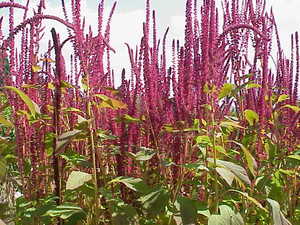
|
Amaranthus cruentus |
https://en.wikipedia.org/wiki/Amaranthus_cruentus
true
Dry, Moist
Full sun
3-11
Red amaranth, komo
Light (sandy), Medium, Heavy (clay)
Amaranthaceae
2
Leaves, Seed
Annual
https://pfaf.org/User/Plant.aspx?LatinName=Amaranthus cruentus
El Salvador, Guatemala, Honduras, Mexico Central, Mexico Gulf, Mexico Southeast, Mexico Southwest, Nicaragua
Afghanistan, Alabama, Albania, Algeria, Altay, Amur, Argentina Northeast, Argentina Northwest, Arizona, Assam, Baleares, Bangladesh, Belgium, Benin, Bolivia, Borneo, Botswana, Brazil Northeast, Brazil South, Brazil Southeast, Brazil West-Central, Bulgaria, Burundi, California, Cambodia, Cameroon, Cape Provinces, Cape Verde, Central European Rus, Chile Central, China North-Central, China South-Central, China Southeast, Chita, Christmas I., Colombia, Connecticut, Corse, Cuba, Cyprus, Czechoslovakia, Dominican Republic, East Aegean Is., East European Russia, Ecuador, Egypt, Ethiopia, Fiji, France, Free State, Germany, Ghana, Great Britain, Guinea, Guinea-Bissau, Gulf of Guinea Is., Haiti, Hawaii, Hungary, Illinois, India, Indiana, Inner Mongolia, Iran, Iraq, Irkutsk, Italy, Ivory Coast, Japan, Jawa, Kazakhstan, Kentucky, Kenya, Kirgizstan, Korea, Kriti, Krym, KwaZulu-Natal, Laccadive Is., Leeward Is., Lesser Sunda Is., Libya, Maine, Malawi, Mali, Manchuria, Maryland, Massachusetts, Mexico Northwest, Michigan, Missouri, Morocco, Mozambique, Myanmar, Nebraska, Nepal, New Caledonia, New Guinea, New Hampshire, New Jersey, New Mexico, New South Wales, New York, New Zealand North, New Zealand South, Niger, Nigeria, North Carolina, North Caucasus, Northern Provinces, Ohio, Oregon, Pakistan, Palestine, Panamá, Paraguay, Pennsylvania, Peru, Philippines, Portugal, Primorye, Puerto Rico, Qinghai, Rhode I., Romania, Rwanda, Sardegna, Saudi Arabia, Sicilia, Sierra Leone, Sinai, Society Is., Somalia, South Carolina, South China Sea, South European Russi, Spain, Sudan, Sumatera, Sweden, Switzerland, Tadzhikistan, Taiwan, Tanzania, Texas, Tibet, Tonga, Tubuai Is., Tunisia, Turkmenistan, Uganda, Ukraine, Utah, Uzbekistan, Venezuela, Vermont, Vietnam, Washington, West Virginia, Western Sahara, Windward Is., Wisconsin, Yemen, Yugoslavia, Zambia, Zaïre
https://powo.science.kew.org/taxon/urn:lsid:ipni.org:names:10631-2
Colouring
Dye, Dynamic accumulator
|
Show
Edit |
|

|
Common Sunflower |
https://en.wikipedia.org/wiki/Helianthus_annuus
true
Fast
Dry, Moist
Full sun, Partial sun/shade
6-9
Common sunflower
Light (sandy), Medium, Heavy (clay)
Asteraceae or compositae
3.0
Flowers, Seed, Stem
Oil, Coffee
Weed potential
Annual
https://pfaf.org/User/Plant.aspx?LatinName=Helianthus annuus
Arizona, California, Mexico Central, Mexico Northeast, Mexico Northwest, Mexico Southwest, Nevada
Alabama, Alaska, Albania, Alberta, Altay, Amur, Argentina Northeast, Argentina Northwest, Argentina South, Arkansas, Assam, Austria, Azores, Baltic States, Bangladesh, Belarus, Belgium, Belize, Bolivia, Botswana, British Columbia, Bulgaria, Buryatiya, Cape Provinces, Caprivi Strip, Central European Rus, Chile Central, Chile North, Chile South, China North-Central, China South-Central, China Southeast, Chita, Colombia, Colorado, Connecticut, Corse, Costa Rica, Delaware, Denmark, District of Columbia, Dominican Republic, East European Russia, East Himalaya, El Salvador, Finland, Florida, France, Free State, Georgia, Germany, Great Britain, Greece, Guatemala, Hainan, Haiti, Honduras, Hungary, Idaho, Illinois, India, Indiana, Inner Mongolia, Iowa, Ireland, Irkutsk, Italy, Japan, Kamchatka, Kansas, Kazakhstan, Kentucky, Khabarovsk, Kirgizstan, Korea, Krasnoyarsk, KwaZulu-Natal, Lesotho, Libya, Louisiana, Magadan, Maine, Manchuria, Manitoba, Maryland, Massachusetts, Mexico Gulf, Mexico Southeast, Michigan, Minnesota, Mississippi, Missouri, Montana, Morocco, Namibia, Nebraska, Nepal, Netherlands, New Brunswick, New Hampshire, New Jersey, New Mexico, New South Wales, New York, New Zealand North, New Zealand South, Newfoundland, North Carolina, North Caucasus, North Dakota, North European Russi, Northern Provinces, Northern Territory, Northwest Territorie, Norway, Nova Scotia, Nunavut, Ohio, Oklahoma, Ontario, Oregon, Pakistan, Palestine, Paraguay, Pennsylvania, Peru, Poland, Primorye, Prince Edward I., Qinghai, Queensland, Québec, Rhode I., Romania, Sakhalin, Sardegna, Saskatchewan, Sicilia, South Australia, South Carolina, South Dakota, South European Russi, Spain, Swaziland, Sweden, Switzerland, Tadzhikistan, Tasmania, Tennessee, Texas, Thailand, Tibet, Transcaucasus, Turkey, Turkey-in-Europe, Turkmenistan, Tuva, Ukraine, Uruguay, Utah, Uzbekistan, Vermont, Victoria, Virginia, Washington, West Himalaya, West Siberia, West Virginia, Western Australia, Wisconsin, Wyoming, Xinjiang, Yakutskiya, Yugoslavia
https://powo.science.kew.org/taxon/urn:lsid:ipni.org:names:119003-2
Blotting paper, Dye, Fiber, Fire starter, Cover crop, Herbicide, Microscope, oil, textiles, Dynamic accumulator
|
Show
Edit |
|

|
Asparagus |
2-9
Full sun, Partial sun/shade
Moist
Light (sandy), Medium, Heavy (clay)
6.5-7.0
Evergreen
1-1.5m
1
Perennial
Herbs
Slow
12-18 inches rows, 6–8inches in row
Seed - direct sow, Seed - transplant, Division
16 weeks before last frost date
10-12 weeks, 1 week after last frost date
2-8 weeks
21-29°c (70-85°f)
true
Shoots, Stem
Sparrow grass
Spargel
Asparagaceae
Europe, Western asia, Afghanistan, Albania, Altay, Austria, Belarus, Bulgaria, Central European Rus, Corse, Czechoslovakia, France, Germany, Greece, Hungary, Iran, Kazakhstan, Krasnoyarsk, Krym, Lebanon-Syria, Mongolia, North Caucasus, Pakistan, Poland, Sicilia, South European Russi, Switzerland, Transcaucasus, Turkey, Turkey-in-Europe, Ukraine, West Siberia, Xinjiang
Alabama, Alberta, Algeria, Argentina Northeast, Argentina Northwest, Argentina South, Arizona, Arkansas, Baltic States, Bangladesh, Belgium, Bolivia, British Columbia, California, Colorado, Connecticut, Costa Rica, Cyprus, Delaware, Denmark, District of Columbia, East European Russia, East Himalaya, Ethiopia, Finland, Florida, Georgia, Great Britain, Idaho, Illinois, Indiana, Iowa, Ireland, Kansas, Kentucky, Labrador, Louisiana, Madagascar, Maine, Manitoba, Marianas, Maryland, Massachusetts, Mauritius, Mexico Central, Mexico Gulf, Mexico Northeast, Mexico Southeast, Mexico Southwest, Michigan, Minnesota, Mississippi, Missouri, Montana, Morocco, Nebraska, Netherlands, Nevada, New Brunswick, New Hampshire, New Jersey, New Mexico, New South Wales, New York, New Zealand North, New Zealand South, Newfoundland, North Carolina, North Dakota, North European Russi, Northwest European R, Norway, Nova Scotia, Ohio, Oklahoma, Ontario, Oregon, Pennsylvania, Portugal, Prince Edward I., Queensland, Québec, Rhode I., Réunion, Sardegna, Saskatchewan, Seychelles, Solomon Is., South Australia, South Carolina, South Dakota, Spain, Sweden, Tasmania, Tennessee, Texas, Trinidad-Tobago, Tunisia, Uruguay, Utah, Vermont, Victoria, Virginia, Washington, West Himalaya, West Virginia, Western Australia, Wisconsin, Wyoming
True
https://en.wikipedia.org/wiki/asparagus
https://pfaf.org/user/plant.aspx?latinname=asparagus officinalis
https://powo.science.kew.org/taxon/urn:lsid:ipni.org:names:531229-1
Fasciculated
3-8inches
8-12 weeks before last frost
Toxic fruits
Coffee
Pest control
|
Asparagus officinalis is a plant native to most of Europe, northern Africa, and western Asia. It is a herbaceous perennial plant that typically grows to around 0.5 to 1.5 meters in height, with slender stems and feathery leaves. The stems are typically green, but some varieties can have purple or white stems. The plant produces small, fragrant white or pink flowers in the spring, which give way to red berries in the fall, which are toxic to humans. Asparagus is a fast-growing plant that prefers well-draining, fertile soil and full sun exposure. It can grow in saline soils where other plants to do not grow. A soil pH below 6 is possible but best is to adjust to 6.5-7.0. It can be grown from seed or from crowns, and typically takes 2-3 years to reach maturity and begin producing edible shoots, which can be harvested for around 8-12 weeks each season. In cold climates, asparagus is winter hardy and can be left in the ground to overwinter. In warmer climates, it may need to be dug up and stored in a cool, dry place during the winter months. The edible shoots of asparagus can be harvested in the spring and early summer. They can be eaten raw or cooked, and have a delicate, slightly sweet flavor. The shoots can be stored in the refrigerator for a few days, but are best used fresh. Asparagus is a low-calorie, nutrient-dense vegetable, with high levels of vitamins A, C, and K, as well as folate and fiber. In addition to its use as a food, asparagus has a number of other uses. It is often used medicinally to treat a variety of conditions, including digestive disorders and urinary tract infections. The plant's leaves and stems can be used as mulch or compost, and the roots can help to fix nitrogen in the soil, making it useful for improving soil health. Asparagus has also been used as a weaving material and as a building material, due to its strength and durability. Asparagus is a valuable plant for wildlife, providing food and habitat for a variety of animals. The plant's flowers attract bees and other pollinators, and the berries are eaten by birds and small mammals. Asparagus is a good companion plant to the Tomato since it repels some harmful root nematodes for Tomatoes and Tomatoes repel the asparagus beetle. |
Show
Edit |
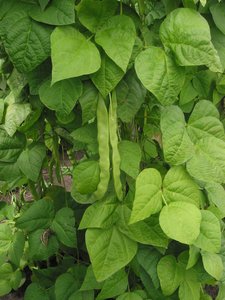
|
Common bean |
2-11
Annual
Full sun
Moist
Light (sandy), Medium, Heavy (clay)
2.0
Vines
Biomass, Dye, antifungal, Nitrogen fixer
true
Leaves, Seed, Seedpod
Seed - transplant, Seed - direct sow
https://en.wikipedia.org/wiki/Phaseolus_vulgaris
Pole bean, Climbing bean, French bean, Bush bean, Dwarf bean, Kidney bean, Green bean
Fabaceae, Leguminosae
Stangenbohne
https://pfaf.org/User/Plant.aspx?LatinName=Phaseolus vulgaris
16-18°c (70-80°f)
6.0-6.8
2.5 cm
16cm
4-10 days
45-85
Fast
Sperzieboon
Costa Rica, Guatemala, Honduras, Mexico Central, Mexico Gulf, Mexico Northeast, Mexico Northwest, Mexico Southeast, Mexico Southwest, Nicaragua, Panamá
Altay, Amur, Andaman Is., Angola, Argentina Northeast, Argentina Northwest, Assam, Baltic States, Bangladesh, Belarus, Bolivia, Bulgaria, Buryatiya, Cameroon, Cayman Is., Central European Rus, Chad, Chita, Colombia, Comoros, Cuba, Czechoslovakia, Dominican Republic, East European Russia, East Himalaya, Ecuador, Ethiopia, Guinea, Gulf of Guinea Is., Haiti, Illinois, India, Iraq, Irkutsk, Jamaica, Jawa, Kazakhstan, Kenya, Khabarovsk, Kirgizstan, Korea, Krasnoyarsk, Kuril Is., Leeward Is., Malaya, Marianas, Maryland, Mongolia, Myanmar, Nepal, New Guinea, New York, Nicobar Is., Nigeria, North Caucasus, North European Russi, Northwest European R, Pakistan, Peru, Philippines, Primorye, Puerto Rico, Queensland, Rwanda, Sakhalin, Senegal, South European Russi, Sri Lanka, Tadzhikistan, Tanzania, Thailand, Togo, Transcaucasus, Trinidad-Tobago, Turkmenistan, Tuva, Uganda, Ukraine, Uzbekistan, Venezuela, Vietnam, Wake I., West Himalaya, West Siberia, Yakutskiya, Zambia, Zaïre
2-4 weeks before last frost
1 week after last frost, 12-14 weeks before first frost
3-5 years
0.4
https://powo.science.kew.org/taxon/urn:lsid:ipni.org:names:514191-1
Coffee, Condiment
|
This entry describes all varieties of the common bean. This includes vining and bush/darf variaties and can have different names depending on their style of growths (see alternate names). These include the kidney bean, the navy bean, the pinto bean, the French bean and the wax bean The common bean, scientific name Phaseolus vulgaris, is a herbaceous annual plant native to the Americas, specifically the regions extending from the southwestern United States to South America. It is a member of the Fabaceae (legume) family. The common bean has a range of different appearances, depending on the variety. Most varieties have a simple, erect stem that grows to a height of 20-60 cm. The leaves are typically green and consist of 3-5 oblong leaflets. The flowers are small and white, pink, or purple in color. The fruit is a legume, which contains the seeds. The common bean is typically a small plant, but some varieties can grow to be quite large, reaching heights of up to 2 meters. The plant grows relatively quickly, with the growing season typically lasting between 60-100 days. The common bean prefers well-drained soil and full sun, but can also grow in partial shade. It is sensitive to frost and should be planted after the last frost date in the spring. To cultivate the common bean successfully, a grower may need to ensure that the soil is adequately fertilized and provide support for the plant to climb, if necessary. The common bean is edible, with the seeds and the young pods being the most commonly consumed parts. The seeds can be cooked and eaten as a protein-rich vegetable, and the young pods can be eaten as a green vegetable. The edible parts can be stored after harvest by drying the seeds or by preserving the young pods in vinegar or oil. The common bean has many uses beyond being a food source. The plant can fix nitrogen in the soil, improving its fertility and making it a useful companion plant for other crops. The dried leaves and stems of the common bean can be used as mulch or as a source of organic matter. In some cultures, the fibers from the stems are used to make ropes or other weaving materials. Additionally, the plant has been used medicinally to treat a variety of ailments. The common bean is also valuable for wildlife. The flowers attract bees and other pollinators, and the plant provides food for a variety of insects, birds, and small mammals. ### Links [Beans Seed Starting Tips @ Harvest to Table](https://harvesttotable.com/beans-seed-starting-tips/) ### Propagation - direct sow Direct-sow beans in spring after all danger of frost has passed and soil is at least 16°C (60°F). In warm-winter regions, sow beans in late summer for harvest in winter. Time sowing so that beans come to harvest before the first frost. |
Show
Edit |
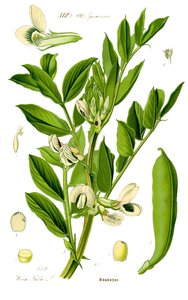
|
Broad Bean |
4-8
Full sun, Partial sun/shade
Moist
Light (sandy), Medium, Heavy (clay)
6.0-6.8
1.0
0.3
Annual
Fast
20cm
Seed - direct sow, Seed - transplant
6 weeks after sowing them in pots
6 weeks after sowing them in pots
21 days
3-5 years
Nitrogen fixer
Leaves, Seed
fava bean, faba bean, Broad bean, or faba bean Varieties with smaller, harder seeds that are fed to horses or other animals are called field bean, tic bean or tick bean Horse bean
Ackerbohne
Fabaceae or Leguminosae
Afghanistan, Iran
Albania, Algeria, Altay, Angola, Argentina South, Assam, Baleares, Bangladesh, Bolivia, Bulgaria, Cameroon, Canary Is., Central European Rus, Chad, China North-Central, China South-Central, China Southeast, Colombia, Corse, Cuba, Cyprus, Czechoslovakia, Dominican Republic, East Aegean Is., East European Russia, Ecuador, Ethiopia, France, Guatemala, India, Iraq, Italy, Jawa, Kenya, Krym, Lebanon-Syria, Leeward Is., Libya, Madeira, Mexico Southwest, Mongolia, Morocco, Myanmar, Nepal, New South Wales, New York, New Zealand North, New Zealand South, Pakistan, Peru, Portugal, Puerto Rico, Rwanda, Sardegna, Sicilia, Spain, Sri Lanka, Sudan, Tibet, Tunisia, Turkey, Turkey-in-Europe, Uruguay, Vermont, Vietnam, West Himalaya, Yemen, Yugoslavia
https://en.wikipedia.org/wiki/Vicia_faba
https://pfaf.org/User/Plant.aspx?LatinName=Vicia faba major
https://powo.science.kew.org/taxon/urn:lsid:ipni.org:names:524737-1
Feb-April; Oct-Nov
sow in deep pots in cool, frost-free place
|
Broad bean (Vicia faba), also known as fava bean or faba bean, is a type of legume that is native to North Africa and the Middle East. It is a popular garden plant, known for its edible beans and attractive purple or white flowers. Broad bean plants have a upright, bushy growth habit and can reach a height of up to 3 feet. The leaves are large and composed of three oval-shaped leaflets, and the flowers are small and clustered in groups of two or three. The beans are produced in long, slender pods that contain two or three beans each. To grow broad beans successfully, it is important to choose a location with well-drained, fertile soil and full sun. The plants should be spaced about 8-12 inches apart, and watered regularly to ensure that the soil stays moist but not waterlogged. Broad beans are generally easy to grow and require little maintenance, but they can be susceptible to pests and diseases, such as aphids and fungal infections. Grows best in temperatures ranging from 60° to 65°F (15-18°C) but will tolerate a range from 40°F (4.4°C) - 75°F (24°C). Broad beans are edible, and the beans can be eaten fresh or frozen, canned or dried for storage. To harvest the beans, the pods should be picked when they are plump and before the beans inside begin to harden. The beans can be removed from the pods by gently squeezing them out. Fresh beans can be stored in the refrigerator for a few days, while dried beans can be stored in an airtight container for several months. In addition to their culinary uses, broad beans also have a number of medicinal properties, and have been used to treat a variety of ailments, including asthma, bronchitis, and anemia. Broad beans are also a valuable food source for many types of wildlife, including birds, insects, and small mammals. The plants provide nectar for bees and other pollinators, and the beans are a popular food for many species of birds. |
Show
Edit |

|
Broccoli |
2-11
Full sun, Partial sun/shade
Moist
Light (sandy), Medium, Heavy (clay)
6.0-7.0
0.9
Annual, Biennial
45cm
6-8 weeks before last frost
7-10 days
4°C (40°F)
50-100
3 to 7 years
Companion
true
Flowers, Leaves, Shoots
Brokkoli
Brassicaceae or Cruciferae
https://pfaf.org/User/Plant.aspx?LatinName=Brassica oleracea italica
|
Broccoli is a plant that is native to the Mediterranean region. It is part of the Brassica oleracea family, which also includes other vegetables such as cauliflower and cabbage. Broccoli plants have green, flowering heads that are similar in appearance to cauliflower. The stems are typically thick and can grow to be quite large, depending on the variety of broccoli. The leaves of the plant are typically dark green and are arranged in a spiral pattern along the stem. When it comes to growing conditions, broccoli prefers cool weather and well-draining soil. It is a relatively fast-growing plant, with the flowering heads typically forming in the first year. To cultivate broccoli successfully, a grower will need to make sure the plant gets enough water and sunlight, and provide it with the necessary nutrients through fertilization. In terms of winter hardiness, broccoli is not very frost-tolerant, so it is typically grown as a cool-season crop in areas with mild winters. In terms of edibility, broccoli is a very nutritious vegetable that is packed with vitamins and minerals. The flowering heads and the stems are both edible, and can be cooked in a variety of ways. After harvest, broccoli can be stored in the refrigerator for several days, or frozen for longer-term storage. ### Propagation - Direct sow Sow seeds 7cm apart, thin when seedlings reach 5-7cm in height. ### Propagation - Transplant Start seeds 6-8 weeks before your last frost date, or 2-3 weeks before last frost date. Plant outside when seedlings are 4-6 weeks old, or have 4-5 leaves. #### Links [Broccoli @ Almanac](https://www.almanac.com/plant/broccoli) |
Show
Edit |

|
Cauliflower |
3-10
Full sun, Partial sun/shade
Moist
Light (sandy), Medium, Heavy (clay)
0.8
Annual, Biennial
3-7 years
Companion, antifungal, Dynamic accumulator
true
Flowers, Leaves
Blumenkohl
Brassicaceae or cruciferae
https://pfaf.org/User/Plant.aspx?LatinName=Brassica oleracea botrytis
|
Annual plant reproduced by seed. |
Show
Edit |

|
Curly Kale |
Biennial, Perennial
Full sun, Partial sun/shade
Moist
Light (sandy), Medium, Heavy (clay)
0.9
Brassicaceae or cruciferae
https://pfaf.org/User/Plant.aspx?LatinName=Brassica oleracea sabellica
3 to 7 years
Shoots
true
|
Show
Edit |
|
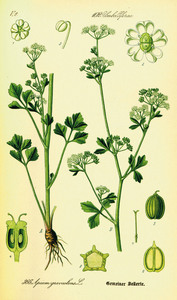
|
Celery |
Full sun, Partial sun/shade
Moist
Light (sandy), Medium
0.6
0.45
Biennial
true
Leaves, Root, Seed
Apiaceae or umbelliferae
https://en.wikipedia.org/wiki/Celery
https://pfaf.org/User/Plant.aspx?LatinName=Apium graveolens dulce
Condiment
|
Show
Edit |
|

|
Zea mays |
2-11
Full sun
Moist
Light (sandy), Medium, Heavy (clay)
2
0.66
Annual
Fast
true
Pollen, Seed, Stem
Oil, Coffee
Maize, corn, abado, able, aburow, agbado, awasi, awi, bara-jowar, bhutta, blefo, bli, buta, chujak, goinjol, gomdhan, igbado, jagung, janar, jonar, junri, kaaba, keto, kolkoti, kon, kono, kukri, maka, makai, makka jonnalu, makka-cholam, makka, makkai, makkari, makoi, masara agwado, massara, mekkejola, milho, mokka-janna, musukojola, naham, nyo, oka, oksusu, shaa, sil ni vavalagi, ta-mank, yu shu shu, ai, amylum maydis, awási, aya, corn oi, 6 corn oil (unhydrogenated), corn silk, corn starch, corn syrup solids, corn|iringu, dent corn, dura shami, field corn, flint corn, gangnaengi, granoturco, indian corn, maidis stigma, mais, maiz, aceite, maize oil, refined, maize starch, majs, maydis amylum, maydis oleum raffinatum, maydis stigma, maíz, aceite refinado, maîs, maïs, ogsusu, oleum maydis, pelos de elafe, pod corn, popcorn, refined maize oil, risoy genime sami, stigmata maidis, styli cum stigmatis zeae maydis, sweet corn, topical starch, to-morokoshi, yu mi shu, yu mi xu, zein, zorrat
Mais
Poaceae or gramineae
Guatemala, Mexico Central, Mexico Southwest
Afghanistan, Alabama, Albania, Aldabra, Algeria, Amur, Andaman Is., Angola, Argentina Northeast, Arizona, Arkansas, Aruba, Assam, Austria, Azores, Bahamas, Baleares, Baltic States, Bangladesh, Belarus, Belgium, Belize, Benin, Bismarck Archipelago, Bolivia, Borneo, Brazil North, Brazil Northeast, Brazil South, Brazil Southeast, Brazil West-Central, Bulgaria, Burkina, Burundi, California, Cambodia, Cameroon, Canary Is., Caroline Is., Cayman Is., Central African Repu, Central European Rus, Chad, Chagos Archipelago, China North-Central, China South-Central, China Southeast, Christmas I., Colombia, Colorado, Comoros, Connecticut, Corse, Costa Rica, Cuba, Cyprus, Czechoslovakia, Djibouti, Dominican Republic, East European Russia, East Himalaya, Ecuador, Egypt, Equatorial Guinea, Ethiopia, Fiji, Florida, France, French Guiana, Galápagos, Gambia, Georgia, Germany, Ghana, Great Britain, Greece, Guinea, Guinea-Bissau, Gulf of Guinea Is., Hainan, Haiti, Hawaii, Honduras, Hungary, Idaho, Illinois, India, Indiana, Iowa, Iraq, Ireland, Italy, Ivory Coast, Jamaica, Japan, Jawa, Kansas, Kazakhstan, Kentucky, Khabarovsk, Kirgizstan, Korea, Kriti, Krym, Laos, Leeward Is., Lesser Sunda Is., Louisiana, Madagascar, Maine, Malaya, Mali, Maluku, Manchuria, Marianas, Marshall Is., Maryland, Massachusetts, Mauritius, Mexico Gulf, Mexico Northeast, Mexico Northwest, Mexico Southeast, Minnesota, Mississippi, Missouri, Montana, Morocco, Mozambique, Myanmar, Nansei-shoto, Nebraska, Nepal, Netherlands, Netherlands Antilles, Nevada, New Caledonia, New Guinea, New Hampshire, New Jersey, New Mexico, New York, Nicaragua, Niger, Nigeria, Niue, North Carolina, North Caucasus, Northwest European R, Ohio, Oman, Ontario, Oregon, Pakistan, Panamá, Pennsylvania, Peru, Philippines, Pitcairn Is., Poland, Portugal, Primorye, Puerto Rico, Queensland, Québec, Rhode I., Rodrigues, Romania, Rwanda, Réunion, Sakhalin, Samoa, Sardegna, Seychelles, Sicilia, Sierra Leone, Somalia, South Carolina, South European Russi, Spain, Sri Lanka, Sudan, Switzerland, Tadzhikistan, Tanzania, Tennessee, Texas, Thailand, Togo, Transcaucasus, Trinidad-Tobago, Tunisia, Turkey, Turkey-in-Europe, Turkmenistan, Ukraine, Uruguay, Utah, Uzbekistan, Vanuatu, Venezuelan Antilles, Vermont, Vietnam, Virginia, Wake I., Washington, West Himalaya, West Virginia, Western Australia, Windward Is., Wisconsin, Wyoming, Yemen, Yugoslavia, Zambia, Zaïre
https://en.wikipedia.org/wiki/Maize
https://pfaf.org/User/Plant.aspx?LatinName=Zea mays
https://powo.science.kew.org/taxon/urn:lsid:ipni.org:names:426810-1
Adhesive, Fire starter, oil, textiles
|
Corn (Zea mays) is a plant native to Central America and Mexico. It is a tall plant with a sturdy stem and large leaves that grow in a spiral pattern around the stem. The plant produces large, brightly colored flowers that give way to ears of corn. The ears are typically yellow, but can also be white, red, or blue. Corn grows to be anywhere from 3-12 feet tall and can grow quickly, depending on the variety. To differentiate corn from similar plants, gardeners and farmers can look for the spiral pattern of the leaves and the presence of ears. Corn is often grown in rows, which can also help to distinguish it from other plants. Corn prefers well-draining, fertile soil and full sun. In order to cultivate it successfully, a grower will need to provide these conditions and also ensure that the plants receive adequate water. Corn is often grown from seed, which should be planted in the ground when the soil has warmed to at least 60 degrees Fahrenheit. Corn is edible, and the edible parts are the kernels that are found on the ears. The ears can be harvested when the kernels are plump and fully developed. They can be stored after harvest by drying them in the sun or by freezing them. Corn has many uses. In addition to being a popular food crop, it can also be used as livestock feed and as a source of biofuel. It can also be used as a building material and for crafting. Corn has medicinal properties and has been used to treat a variety of ailments. It is also valued by wildlife, as it provides food and shelter for birds, small mammals, and insects. |
Show
Edit |
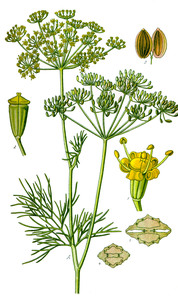
|
Anethum graveolens |
2-11
Full sun
Moist
Light (sandy), Medium
0.8
Annual
Herbs
Medium
15cm x 30cm
Essential Oil, Pest control, Fragrance
true
Leaves, Seed
Condiment, Tea
Dill
Apiaceae or umbelliferae
Algeria, Chad, Cyprus, Gulf States, Iran, Lebanon-Syria, Libya, Morocco, Oman, Saudi Arabia, Tunisia
Afghanistan, Alabama, Albania, Alberta, Altay, Andaman Is., Angola, Argentina Northeast, Arizona, Arkansas, Assam, Austria, Azores, Bahamas, Baleares, Baltic States, Bangladesh, Belarus, Belgium, Brazil South, Brazil Southeast, British Columbia, Bulgaria, California, Cameroon, Canary Is., Cape Verde, Cayman Is., Central European Rus, China North-Central, China South-Central, China Southeast, Connecticut, Costa Rica, Cuba, Czechoslovakia, Delaware, Denmark, Dominican Republic, East Aegean Is., East European Russia, East Himalaya, Ecuador, Eritrea, Ethiopia, Finland, France, Ghana, Great Britain, Greece, Guatemala, Haiti, Hawaii, Hungary, Illinois, India, Indiana, Iowa, Iraq, Italy, Jamaica, Kansas, Kazakhstan, Kentucky, Kenya, Kriti, Krym, Laos, Leeward Is., Louisiana, Madeira, Maine, Manitoba, Maryland, Massachusetts, Michigan, Minnesota, Missouri, Mongolia, Montana, Mozambique, Nebraska, Nepal, Netherlands, New Jersey, New York, Nicobar Is., Niger, Nigeria, North Carolina, North Dakota, Northwest European R, Norway, Ohio, Oklahoma, Ontario, Oregon, Pakistan, Palestine, Pennsylvania, Peru, Portugal, Primorye, Puerto Rico, Québec, Rhode I., Romania, Saskatchewan, Sicilia, Somalia, South Dakota, South European Russi, Spain, Sudan, Sweden, Switzerland, Tadzhikistan, Tanzania, Texas, Thailand, Transcaucasus, Trinidad-Tobago, Turkey, Turkey-in-Europe, Ukraine, Uzbekistan, Vietnam, Virginia, Wake I., Washington, West Virginia, Windward Is., Wisconsin, Yugoslavia
https://en.wikipedia.org/wiki/Dill
https://pfaf.org/User/Plant.aspx?LatinName=Anethum graveolens
https://powo.science.kew.org/taxon/urn:lsid:ipni.org:names:837530-1
Dill
|
Dill (Anethum graveolens) is a plant native to the eastern Mediterranean region and West Asia. It is an annual herb that grows to a height of about 1-2 feet and has delicate, feathery leaves. The plant has small yellow flowers that bloom in the summer. Dill is a popular herb in many cuisines, especially in European and Middle Eastern dishes. It is used to flavor soups, stews, fish, and pickles. The leaves and seeds of dill are both edible and can be used fresh or dried. The seeds have a more pungent flavor than the leaves and are often used in pickling. Dill can be stored by drying or freezing the leaves and seeds. Dill prefers full sun and well-drained soil. It is easy to grow and can be started from seed or from transplants. Dill is not winter hardy and will die off in the winter. In addition to its culinary uses, dill has been used medicinally to aid in digestion and to reduce inflammation. It has also been used as a natural insect repellent. The plant is attractive to many types of beneficial insects, making it a valuable addition to any garden. |
Show
Edit |

|
Kohlrabi |
4-8
Full sun, Partial sun/shade
Moist
Light (sandy), Medium, Heavy (clay)
0.5
Annual, Biennial
Fast
true
Leaves, Stem
German turnip
Kohlrabi
Brassicaceae or cruciferae
https://pfaf.org/User/Plant.aspx?LatinName=Brassica oleracea gongylodes
|
Show
Edit |
|
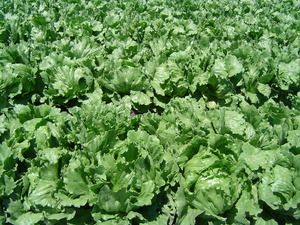
|
Lactuca sativa |
5-9
Annual, Biennial
Full sun, Partial sun/shade
Moist
Light (sandy), Medium
0.9
Herbs
true
Leaves, Seed
https://en.wikipedia.org/wiki/Lettuce
Garden lettuce
Asteraceae or compositae
Blattsalat
Oil
https://pfaf.org/User/Plant.aspx?LatinName=Lactuca sativa
Iraq
Alabama, Antipodean Is., Argentina Northeast, Assam, Austria, Baleares, Baltic States, Bangladesh, Belize, Bolivia, Bulgaria, Burkina, California, Cameroon, Canary Is., Cape Provinces, Cape Verde, Caroline Is., Central European Rus, Chad, China North-Central, Colombia, Connecticut, Corse, Costa Rica, Cuba, Cyprus, Czechoslovakia, Delaware, District of Columbia, Dominican Republic, East European Russia, East Himalaya, Ecuador, Egypt, El Salvador, Fiji, Finland, France, Free State, Germany, Great Britain, Guatemala, Haiti, Hawaii, Honduras, Hungary, Idaho, Illinois, Indiana, Inner Mongolia, Ireland, Italy, Jamaica, Jawa, Kazakhstan, Khabarovsk, Korea, Krym, Lebanon-Syria, Madeira, Maine, Marianas, Marshall Is., Massachusetts, Mauritania, Mauritius, Mexico Southeast, Michigan, Missouri, Myanmar, Nepal, Netherlands, New Guinea, New Hampshire, New Jersey, New Mexico, New York, Nicaragua, Niue, North Carolina, North Caucasus, North Dakota, North European Russi, Northwest European R, Ohio, Oklahoma, Oman, Ontario, Oregon, Pakistan, Panamá, Paraguay, Pennsylvania, Peru, Philippines, Poland, Portugal, Primorye, Puerto Rico, Rhode I., Romania, Réunion, Sardegna, Sicilia, South European Russi, Spain, Sweden, Switzerland, Taiwan, Transcaucasus, Trinidad-Tobago, Tubuai Is., Turkey, Turkey-in-Europe, Ukraine, Uzbekistan, Venezuela, Vermont, Vietnam, Wake I., Washington, West Virginia, Yugoslavia
30cm
https://powo.science.kew.org/taxon/urn:lsid:ipni.org:names:228239-1
Hair, oil, Pest control
|
Lettuce, Lactuca sativa, is a plant native to the Mediterranean region. It has green, elongated leaves that form a loose head. The stem is relatively short and the plant grows to a height of about 8-12 inches. Lettuce is a fast-growing plant, with some varieties able to be harvested in as little as 45 days. Lettuce can be differentiated from similar plants by its elongated leaves and loose head formation. It is also relatively short compared to other leafy green plants like kale and spinach. Lettuce prefers cool temperatures and grows best in full sun or partial shade. It is a hardy plant and can tolerate light frost, but will not survive extreme cold. To cultivate lettuce successfully, growers should ensure that the soil is well-drained and moist, and that the plants are spaced appropriately. Lettuce is edible and the leaves can be eaten raw in salads or cooked. The leaves can also be stored by washing and drying them, and then wrapping them in a damp paper towel before placing them in the refrigerator. Lettuce has a number of uses. It is a popular ingredient in salads and other dishes, and has been used medicinally to treat a variety of ailments, including insomnia and digestive issues. |
Show
Edit |

|
Allium cepa |
3-9
Annual
Full sun
Moist
Light (sandy), Medium
0.6
Herbs
Flowers, Leaves, Root, Seed
Seed - direct sow, Seed - transplant
https://en.wikipedia.org/wiki/Onion
Garden onion
Alliaceae
Zwiebel
https://pfaf.org/User/Plant.aspx?LatinName=Allium cepa
50°f, 10°c
Seed indoors 6 weeks before transplanting in the garden
2-6 inches
6.0-7.0
Allium
Turkmenistan
Algeria, Argentina Northeast, Arkansas, Baltic States, Bangladesh, Belarus, Bulgaria, California, Cambodia, Canary Is., Central European Rus, China North-Central, China South-Central, China Southeast, Colombia, Cuba, Czechoslovakia, Dominican Republic, East Aegean Is., East European Russia, East Himalaya, Ecuador, Egypt, Ethiopia, Fiji, France, Galápagos, Guinea-Bissau, Haiti, Illinois, India, Iraq, Italy, Jamaica, Kansas, Kentucky, Kirgizstan, Korea, Krym, Libya, Louisiana, Madeira, Manchuria, Mauritania, Mexico Central, Mexico Gulf, Mexico Northeast, Mexico Southeast, Mexico Southwest, Minnesota, Montana, Morocco, New York, Niue, North European Russi, Northwest European R, Oregon, Pakistan, Puerto Rico, Seychelles, South European Russi, Spain, Tadzhikistan, Texas, Thailand, Tibet, Tonga, Trinidad-Tobago, Ukraine, Uzbekistan, Vermont, Washington, West Himalaya, West Siberia, Wisconsin, Xinjiang, Yugoslavia
Spring or fall
0.3
https://powo.science.kew.org/taxon/urn:lsid:ipni.org:names:527795-1
Cosmetic, Dye, Hair, Polish, Rust
true
|
Onion (Allium cepa) is a plant species in the family Amaryllidaceae. It is native to central Asia and is commonly grown as a vegetable in many parts of the world. Onions are biennial plants, meaning they typically have a two-year life cycle. In the first year, the onion forms a small, rounded bulb with thin, papery skin. In the second year, the onion will produce a tall stem with hollow, elongated leaves and a small, spherical flower head. Onions are typically grown for their bulbs, which are used as a food ingredient in many dishes. The bulbs can vary in size and shape, depending on the variety, but are generally spherical or oblong in shape and range in size from about 2-4 inches in diameter. Onions are commonly differentiated by their color, which can range from white to yellow to red. Onions prefer well-drained soil that is rich in organic matter. They should be planted in a sunny location and will benefit from regular watering, especially during dry periods. Onion bulbs can be harvested when they reach the desired size, typically after about 100-150 days of growth. To store onions, they should be dried and cured in a cool, dry place for about two weeks before being placed in a mesh bag or other breathable container. Onions are edible and are commonly used as a food ingredient in many dishes. The bulbs are the most commonly used part of the plant, but the leaves and stems can also be used in cooking. Onions have a pungent, spicy flavor and are often used to add flavor to soups, stews, and other dishes. Onions can be stored for several months if properly dried and cured. In addition to their use as a food ingredient, onions have also been used for their medicinal properties. They have been used to treat a variety of ailments, including coughs, colds, and respiratory infections. Onions are also sometimes used as a natural fertilizer, due to the high levels of sulfur and other nutrients they contain. Onions are not known to provide significant value to wildlife. They are not a preferred food source for most animals and do not provide any significant habitat value. However, some insects, such as the onion maggot, can be pests of onion crops. |
Show
Edit |
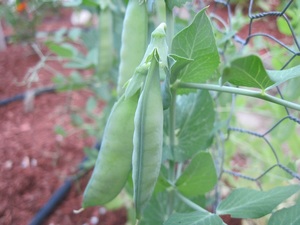
|
Pea |
3-9
Annual
Full sun
Moist
Light (sandy), Medium
2.0
Vines
Nitrogen fixer
true
Leaves, Seed, Shoots
https://en.wikipedia.org/wiki/Pea
Fabaceae or leguminosae
Erbse
https://pfaf.org/User/Plant.aspx?LatinName=Pisum sativum
Afghanistan, Albania, Algeria, Bulgaria, Corse, Cyprus, Egypt, France, Greece, Iran, Iraq, Italy, Krym, Lebanon-Syria, Libya, Morocco, North Caucasus, Palestine, Portugal, Romania, Sardegna, Sicilia, Spain, Transcaucasus, Tunisia, Turkey, Turkey-in-Europe, Turkmenistan, Ukraine, Yugoslavia
Alabama, Altay, Amur, Andaman Is., Assam, Austria, Baltic States, Bangladesh, Belarus, Belgium, Buryatiya, California, Canary Is., Cayman Is., Central European Rus, China North-Central, China South-Central, Chita, Colombia, Costa Rica, Cuba, Czechoslovakia, Dominican Republic, East Aegean Is., East European Russia, East Himalaya, Ethiopia, Fiji, Haiti, Idaho, Illinois, India, Irkutsk, Kamchatka, Kazakhstan, Kenya, Khabarovsk, Kirgizstan, Korea, Krasnoyarsk, Laos, Madeira, Magadan, Marianas, Maryland, Mexico Southwest, Mongolia, Mozambique, Myanmar, Nepal, New Guinea, New South Wales, New York, New Zealand North, New Zealand South, Nigeria, North European Russi, Northwest European R, Oregon, Pakistan, Primorye, Puerto Rico, Rwanda, Sakhalin, South Australia, South European Russi, South Georgia, Sri Lanka, Tadzhikistan, Tibet, Trinidad-Tobago, Tuva, Uganda, Uzbekistan, Vermont, Vietnam, Washington, West Himalaya, West Siberia, Yakutskiya, Yemen
Lathyrus oleraceus
https://powo.science.kew.org/taxon/urn:lsid:ipni.org:names:501912-1
3-5 years
0.3
https://powo.science.kew.org/taxon/urn:lsid:ipni.org:names:60454055-2
|
Peas are a type of legume, native to western Asia and the Near East. They are an annual plant, meaning they grow, flower, and produce seeds within a single growing season. Peas have tendrils that allow them to climb, and their leaves are typically made up of two oblong leaflets and a tendril on a single petiole. Peas produce clusters of small, fragrant flowers that can be white, pink, or purple in color. The flowers give way to pod-like fruits that contain the peas. Peas are a cool-season crop, and prefer to grow in well-drained soil that is high in organic matter. They can tolerate some shade, but will produce the best yields when grown in full sun. Peas can be differentiated from similar plants by their tendrils and the clusters of small, fragrant flowers that they produce. Peas are a relatively small plant, typically growing to a height of one to two feet. They can be grown in rows or as a companion plant, and will typically take between 60 and 90 days to reach maturity. Peas are not winter hardy, and should be planted in the spring as soon as the soil can be worked. Peas are edible, and the seeds inside the pods can be eaten fresh or dried for storage. The leaves and stems of the pea plant can also be eaten, and are a good source of vitamins and minerals. Peas can be used in a variety of dishes, and are a common ingredient in soups, stews, and casseroles. In addition to their culinary uses, peas are also valued for their ability to fix nitrogen in the soil. This makes them a valuable crop for improving soil fertility, and they are often grown as a cover crop or rotated with other crops to improve the overall health of the soil. Peas are also valued by wildlife, and their flowers and seeds are a favorite food for birds and other animals. |
Show
Edit |

|
Raphanus sativus |
2-11
Full sun, Partial sun/shade
Moist
Light (sandy), Medium, Heavy (clay)
0.5
0.3
Annual
Roots
Fast
true
Flowers, Leaves, Root, Seed, Seedpod
Oil
Cultivated radish
Rettich
Brassicaceae or cruciferae
Greece, Italy, Sicilia, Yugoslavia
Alabama, Alaska, Algeria, Altay, Andaman Is., Angola, Argentina Northeast, Argentina Northwest, Argentina South, Arizona, Arkansas, Assam, Baleares, Baltic States, Bangladesh, Belarus, Belgium, Bermuda, Bolivia, Brazil South, Brazil Southeast, British Columbia, Bulgaria, California, Canary Is., Caroline Is., Central European Rus, Chile Central, Chile North, Chile South, China North-Central, China South-Central, China Southeast, Colombia, Colorado, Connecticut, Corse, Costa Rica, Cuba, Cyprus, Delaware, District of Columbia, Dominican Republic, East Aegean Is., East European Russia, East Himalaya, Ecuador, Egypt, El Salvador, Eritrea, Ethiopia, Fiji, Florida, Galápagos, Georgia, Gilbert Is., Guatemala, Gulf of Guinea Is., Gulf States, Hainan, Haiti, Hawaii, Idaho, Illinois, India, Indiana, Inner Mongolia, Iowa, Iraq, Japan, Jawa, Kansas, Kazakhstan, Kazan-retto, Kenya, Korea, Kriti, Krym, Kuwait, Labrador, Lebanon-Syria, Leeward Is., Libya, Louisiana, Madeira, Maine, Manchuria, Manitoba, Marianas, Marshall Is., Maryland, Massachusetts, Mauritania, Mexican Pacific Is., Mexico Northwest, Michigan, Minnesota, Mississippi, Missouri, Montana, Morocco, Nansei-shoto, Nebraska, Nepal, Nevada, New Brunswick, New Caledonia, New Hampshire, New Jersey, New Mexico, New South Wales, New York, Newfoundland, Nicobar Is., North Carolina, North Dakota, North European Russi, Northern Provinces, Nova Scotia, Ohio, Oklahoma, Oman, Ontario, Oregon, Pakistan, Palestine, Paraguay, Pennsylvania, Portugal, Primorye, Prince Edward I., Puerto Rico, Qinghai, Queensland, Québec, Rhode I., Rwanda, Sardegna, Saskatchewan, Saudi Arabia, South Australia, South Carolina, South Dakota, South European Russi, Spain, Sri Lanka, Sudan, Sumatera, Switzerland, Tadzhikistan, Tanzania, Tasmania, Texas, Tibet, Tunisia, Turkey, Turkey-in-Europe, Turkmenistan, Ukraine, Uruguay, Utah, Uzbekistan, Victoria, Vietnam, Virginia, Wake I., Washington, West Himalaya, West Virginia, Western Australia, Windward Is., Wisconsin, Wyoming, Xinjiang, Yemen, Zimbabwe
https://en.wikipedia.org/wiki/Radish
https://pfaf.org/User/Plant.aspx?LatinName=Raphanus sativus
https://powo.science.kew.org/taxon/urn:lsid:ipni.org:names:77159305-1
Weed potential
Animal feed, Cover crop, oil
|
The radish, also known as Raphanus sativus, is a plant native to southwestern Asia and the eastern Mediterranean region. It is a cool-season annual that grows quickly, often maturing in just a few weeks. The radish has a distinctive round or oblong shape, with a crisp and juicy texture. Its skin is typically red or white, but can also be purple, yellow, or black. The leaves of the radish are elongated and dark green in color, while its flowers are small and white or yellow in color. Radishes are relatively small, typically growing to be about four inches long and two inches wide. They prefer well-drained soil that is high in organic matter, and can be grown in a variety of climates, including temperate and subtropical regions. Radishes are typically differentiated from similar plants, such as turnips, by their smaller size and more pungent flavor. They can be harvested at any stage of their growth, but are typically harvested when they are young and tender for the best flavor. To cultivate radishes successfully, a grower will need to plant them in well-prepared soil, water them regularly, and thin out the plants to prevent overcrowding. Radishes are generally hardy and can tolerate frost, making them a good choice for a fall or winter garden. The edible parts of the radish plant are the root and the leaves. The root can be eaten raw, cooked, or pickled, while the leaves can be used in salads or cooked like other leafy greens. After harvest, the roots can be stored in a cool and dark place, such as a root cellar, to prolong their shelf life. Radishes have a number of uses, both in the garden and beyond. In the garden, they can be used as a companion plant to deter pests and improve the health of other plants. In addition to their use in cooking, radishes have also been used medicinally, with some evidence suggesting that they may have anti-inflammatory and digestive health benefits. Radishes are also a valuable food source for wildlife, providing a source of nutrition for birds and small mammals. They are a popular food for bees and other pollinators, and can help to attract these beneficial insects to the garden. |
Show
Edit |
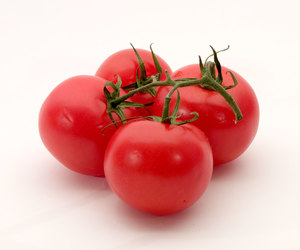
|
Tomato |
10-12
Annual, Perennial
Full sun
Moist
Light (sandy), Medium, Heavy (clay)
2.0
True
Fruit, Seed
https://en.wikipedia.org/wiki/Tomato
Fast
Garden tomato, Dumádu, Garden tomato, Love apple, Lycopersicum esculentum, Tomate, Tomato, Tomato extract containing lycopene, Tomato|thakkali, Tumatis, Lycopersicon esculentum
Solanaceae
Tomate
Oil
https://pfaf.org/User/Plant.aspx?LatinName=Solanum lycopersicum, https://pfaf.org/User/Plant.aspx?LatinName=Lycopersicon esculentum
Start seeds indoors 5-6 weeks before last frost
In containers or in rows in beds around last frost date
6.2-6.8
70-80°f
Peru
Alabama, Alaska, Andaman Is., Angola, Arizona, Arkansas, Assam, Austria, Azores, Bahamas, Bangladesh, Belarus, Benin, Bolivia, British Columbia, Bulgaria, Burkina, California, Cambodia, Cameroon, Canary Is., Cape Verde, Caroline Is., Central African Repu, Chagos Archipelago, Chatham Is., Christmas I., Colombia, Comoros, Connecticut, Cook Is., Costa Rica, Cuba, Cyprus, Czechoslovakia, Delaware, Dominican Republic, East Aegean Is., East European Russia, East Himalaya, Ecuador, Fiji, Florida, Galápagos, Georgia, Gilbert Is., Gulf of Guinea Is., Haiti, Hawaii, Illinois, India, Indiana, Iowa, Ivory Coast, Jawa, Kansas, Kazakhstan, Kentucky, Korea, Laccadive Is., Laos, Leeward Is., Line Is., Louisiana, Madagascar, Madeira, Maine, Malawi, Mali, Marianas, Marquesas, Marshall Is., Maryland, Massachusetts, Mauritania, Mauritius, Michigan, Mississippi, Missouri, Montana, Mozambique, Myanmar, Namibia, Nansei-shoto, Nauru, Nebraska, Nepal, Nevada, New Brunswick, New Caledonia, New Hampshire, New York, New Zealand North, Nicaragua, Nicobar Is., Niue, North Carolina, North Dakota, Nova Scotia, Ogasawara-shoto, Ohio, Ontario, Oregon, Pakistan, Panamá, Pennsylvania, Philippines, Pitcairn Is., Puerto Rico, Québec, Rhode I., Réunion, Saskatchewan, Selvagens, Society Is., South Carolina, South European Russi, Tadzhikistan, Taiwan, Tennessee, Texas, Trinidad-Tobago, Tuamotu, Tubuai Is., Turkey, Turkmenistan, Tuvalu, Utah, Uzbekistan, Venezuela, Vermont, Vietnam, Virginia, Wake I., Wisconsin, Zambia, Zaïre, Zimbabwe
1.00
https://powo.science.kew.org/taxon/urn:lsid:ipni.org:names:316947-2
|
The tomato is a flowering plant native to South America. It is a member of the nightshade family and closely related to the potato. The tomato plant typically grows to a height of 1-3 meters and has a weak, hairy stem. The leaves are arranged alternately on the stem and are typically dark green in color. The plant produces small yellow or white flowers, which develop into the fruit we know as tomatoes. The fruit itself is typically red, but can also be yellow, orange, green, or purple. Indeterminate tomato plants are perennials in their native habitat, but are cultivated as annuals. Determinate, or bush, plants are annuals that stop growing at a certain height and produce a crop all at once. Tomatoes prefer warm, sunny growing conditions and well-drained, humus-rich soil. They can be grown in a variety of soil types, but perform best in soil with a pH between 6 and 6.8. In order to cultivate tomatoes successfully, growers may need to provide support for the plant (such as a stake or cage) to prevent the fruit from weighing down the stem, and may also need to water and fertilize the plant regularly. Tomatoes are generally considered to be frost-sensitive, so in areas with cold winters they may need to be grown in a greenhouse or indoors. There are a great number of cultivars. The edible parts of the tomato plant are the fruit and the leaves. The fruit can be eaten raw or cooked, and is commonly used in a variety of dishes, such as salads, sandwiches, and pasta. The leaves, although not commonly eaten, are also edible and have a slightly bitter taste. After harvest, tomatoes can be stored at room temperature, in a cool place, or in the refrigerator. |
Show
Edit |